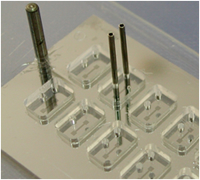Nucleic Acid Bioengineering
Nucleic Acid Bioengineering is focused on two major areas:
A) Plasmid biopharmaceuticals - the specific objectives are to address the scientific/technological challenges associated with plasmid biopharmaceuticals and their application in gene therapy or DNA vaccination, by combining biomolecular engineering studies with bioprocess engineering.
B) Microchips for biorecognition - the specific objectives are to co-develop thin-film microchip platforms for the manipulation of biomolecules and detection of biorecognition events.
A. Plasmid biopharmaceuticals
Gene therapy and DNA vaccination have emerged in the last two decades as promising alternatives for the treatment and prevention of genetic disorders and acquired diseases. Non-viral vectors, such as naked plasmids, constitute a safer gene delivery alternative to viral vectors due to their lower toxicity and larger gene capacity. Scientists at BERG are working in the design of plasmid biopharmaceuticals to improve their therapeutic performance, and in plasmid manufacturing in order to devise better production and purification alternatives.
Research Projects
Structural stability of plasmids
Studies on the nuclease barriers to gene expression during plasmid trafficking through the cytosol of mammalian cells are performed with the goal of constructing plasmid vectors with an increased resistance to nucleolytic activity and thus with a higher transfection activity.
Plasmid manufacturing
Processes for the production of plasmid vectors are conceptually designed, developed, optimised and compared. The impact of specific plasmid structural elements in the performance of upstream and downstream processes (tangential flow filtration, fixed bed and membrane chromatography, aqueous two-phase extraction, precipitation) and in the quality of the final product is evaluated. Analytical procedures to monitor manufacturing and control product quality are also developed. Prof. João Queiroz from Universidade da Beira Interior, Covilhã, Portugal and Dr. Stefan from Sartorius, collaborate in different aspects of this project.
DNA vaccine prototyping
DNA vaccine candidates are constructed by cloning parasitic antigenic proteins associated with sleeping sickness disease. the vaccine prototypes are tested in mice models for their ability to generate cellular and humoral responses, and to provide protection against the infectious agent. This project is developed in collaboration with Dr. Jean Rodgers from the University of Glasgow, Glasgow, UK and Prof. Jorge Atouguia and Dr. Marcelo Silva from IHMT, Instituto de Higinene e Medicina Tropical, Lisbon.
B. Microchips for biorecognition
The conjugation of nano/microfabrication tools and processes with biological systems is expected to yield devices which will revolutionarize Biotechnology and Medicine. Among many others, the potential applications of Nanobiotechnology include the study of cell physiology at the molecular scale and the development of Lab-on-Chip microtechnologies for diagnostics. The research developed in close collaboration with INESC - Microsystems and Nanotechnologies (Prof. João Pedro Conde and Dr. Virgina Chu), aims to apply thin film technologies to the development of biochips for the manipulation/detection of DNA.
Research Projects
DNA and protein microchips
Thin film technologies, chemical modification, microfluidics and electronic addressing are used to develop microchips aimed at molecular recognition of specific analytes (e.g. oligonucleotide hybridization). The core of the chips is a flat surface with oligonucleotide or protein probes chemically/physically linked at locations spatially resolved at 10 to 100 μm. Other possible features include: i) the presence of microelectrodes beneath the biomolecule containing areas to generate electric fields and gradients that accelerate the kinetics of binding and recognition and ii) the presence of a network of microfluidic chanels to handle and distribute fluids. Amorphous silicon photodetectors are also developed for the optoelectronic detection of coloured, chemiluminescent and fluorescent molecules in thin film chips. The presence of these molecules ultimately reports specific biorecognition events such as DNA hybridization or antibody/antigen binding.

Research Projects:

